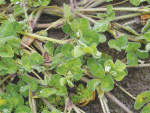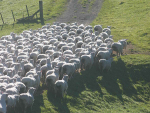Mature grazing livestock are generally very well-adapted to maintain a comfortable body temperature regardless of the weather.
In winter, as long as they remain well fed and have good body condition, their body metabolism produces enough heat for them to withstand cold or wet weather over prolonged periods. Breeds with thick coats or fleece are insulated against heat losses; mature animals also instinctively seek shelter if it is available.
But even mature livestock can be seriously affected if bad weather coincides with times when they are already under stress – for example, immediately after shearing or in the last few weeks of pregnancy. The weather in the weeks leading up to lambing can be just as important as the weather during lambing in determining lamb survival rates.
This is because the ewe experiences very high metabolic demands in late pregnancy, especially if carrying multiple lambs. She may also reduce her feed intake at this time and have to mobilise fat reserves to maintain her heat balance.
If also exposed to cold, wet, windy weather, the ewe may come under significant thermal stress, and will shift resources away from her lambs in a bid to keep herself warm. So, while a wellfed ewe is considered ‘the best shelter a lamb can have’, protecting ewes from bad weather before lambing will contribute significantly to the chances of good lamb birth weights and survival.
New-born lambs are challenged by exposure and the risk of starvation from the moment they are born.
A new-born lamb has to endure the stress of birth; some 17-27% of lamb losses are due to dystocia (difficult birth). Once born, a lamb has to increase its internal heat production markedly – by an estimated 15 times – to maintain its body temperature.
The colder the external air temperature, the greater the immediate stress on the lamb.
It’s important for a lamb’s survival for its mother to bond with it, lick it dry, and suckle it as soon as possible after birth. If the lamb is too cold or weak to suckle early in life, or if it is mismothered, its metabolic rate declines. It then becomes even weaker as its very limited body reserves are depleted.
If a lamb is wet from amniotic fluid and/or rain and snow, it will lose yet more heat through evaporation.
The ambient temperature experienced by a new-born lamb depends on the air temperature and also the windchill, which is directly determined by wind speed. The greater the windchill, the greater an animal’s heat loss.
Any type of shelter slows the wind speed and reduces windchill. Critical extra minutes of a lamb’s life may be gained, during which time a ewe could return to her lamb and get it to suckle, or a shepherd could intervene to help it survive.
Even at very mild temperatures, a wet, hungry new-born lamb will be thermally stressed. But once on its feet and suckling, a lamb can follow its mother, use her for shelter, and continue to suckle to replace heat losses.
Multiple births usually result in lighter lambs. These lambs are particularly vulnerable to heat loss; they have lower fat reserves than heavier lambs, and a high surface area to body weight, increasing heat loss.
Lighter lambs are therefore also likely to maintain their suckling drive for a shorter time than heavier lambs, reducing the time available for successful mothering up.
Providing shelter for ewes known to be carrying multiple lambs should therefore be a priority, both to protect the ewes before lambing, and to give the lambs a better chance of survival once born.
Source Beef+Lamb NZ











